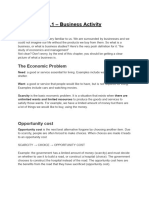0 ratings0% found this document useful (0 votes)
164 viewsNotes
Uploaded by
api-262367281Copyright
© © All Rights Reserved
Available Formats
Download as DOCX, PDF, TXT or read online on Scribd
0 ratings0% found this document useful (0 votes)
164 viewsNotes
Uploaded by
api-262367281Copyright
© © All Rights Reserved
Available Formats
Download as DOCX, PDF, TXT or read online on Scribd
You are on page 1/ 13
Section 1: Understanding business activity
Unit 1: Business activity
The economic problem: needs, wants, and scarcity
- Needs: those things that it's necessary for your life. Ex: air, water, food, shelter, etc.
- Wants: those things you would like to be able to buy and own. Ex: laptop, accessory,
etc.
- The things we wants are unlimited but because financial insufficiency, we can't own
them.
The economic problem - the real cause
- Land- this term is used to cover all of the natural resources provided by natural and
includes fields and forests, oil, gas, metals and other mineral resources.
- Labour - this is the number of people available to make products.
- Capital - this is finance, machinery and equipment needed for the manufacturer of
goods.
- Enterprise - this is the skill and risk-taking ability of the person who brings the other
resources of factors of production together to product a good or service.
Limited resources: the need to choose
- Opportunity cost the second choice
- Ex: if you go into a CD's shop and you decided between a expensive CD or a MP3. If
tyou choose MP3 then the CD will be opportunity cost.
Specialisation: the best use of limited resources
- It is important to use these resources in the most efficiency ways possible.
- Specialisation is now very common because:
+ Specialised machinery and technology are nowwidely available.
+ Increasing competition means that business have to keep costs low.
+ Most people recognise that higher living standards can result from being specialised.
Specialisation and the division of labour
- Division of labour is divide up the making of tables into different jobs and making
each other a specialist at just one task.
The purpose of business activity
- To combine the factors of production to make products which will satisfy people's
wants.
- Business activity therefore:
+ Combines scarce factors of production to produce goods and services.
+ Produces goods and services which are needed to satisfy the needs and wants of the
population.
+ Employs people as workers and pays them wages to allow them to consume products
made by other people.
Added Value
- All businesses attempt to added value. If not:
+ Other costs cannot be paid for.
+ No profit will be made.
Why is added value is important?
- Because sales revenue is greater than the cost materials bought in by the business.
How could a business increase added value?
- Two main ways:
+ Increase selling price but keep the cost of materials the same.
+ Reduce the cost of materials but keep the price the same.
Unit 2: Classification of businesses
Stages of economic activity
- Primary sector - Involves the Earth natural resources: farming, fishing, forestry, etc.
- Secondary sector - taking the materials and resources provided by the primary sector
and converting them into manufactured or processed goods.
- Tertiary sector - Involves providing services to both consumers and other businesses:
transport, banking, retail, etc.
Relative importance of economic sectors
- Three sectors of the economy are compared by:
+ Percentage of the country's total number of workers employed in each sector or
+ Value of output of goods and services and the proportion this is of total national
output.
- In some coutries, primary industries employ many people than service industries. The
level of employment and output in the primary sector in these countries are likely to be
higher than the other two sectors. In countries which started up manufacturing
industries, it is opposite with the first case. Such contries are often called the most
developed countries.
Changes in sector importance
- There are several reasons for changes in the realative importance of the three sectors
over time:
+ Sources of some primary products, become deplepted.
+ Most developed economies are losing competitiveness in manufactoring to the newly
industrialised countries.
+ consumers tend to spend a higher proportion of their income on services than on
manufactured products.
Mixed coconomy
Every country in the world has a mixed economy with a:
+ private sector- bussinesses not owned by the government.
+ public sector: government or state- owned and controlled businesses and
organisations.
Mixed economies- recent changes
Governments have changed the balance between the private sector and public sector in
their economies by selling some public sector businesses to private sector businesses.
This call privatisation. These processes are likely to continue.
Unit 3: Enterprise, business growth and size
Enterprise and entrepreneurship
- Entreprenuer is a person who organises, operates and takes the risk for new business
venture.
Benefits of being an entrepreneur Disadvantages of being an entrepreneur
- Independence - able to choose how to use
time and money.
- Able to put own ideas into practice
- May become famous and sucessful is the
business grows.
- Able to make use of personal interests
and skills.
- May be profitable and the income might
be higher than working as an employee for
another business.
- Risk - many new entrepreneurs's
businesses fail, especially if there is poor
planing.
- Capital - entrepreneur will have to put
their own money into the business and,
possibly, find other sources of capital.
- Lack of knowledge and experience in
starting and operating a business.
- Opportunity cost - lost income from not
being an employee of another business.
Characteristics of successful entrepreneurs
Characteristics of successful
entrepreneurs
Reasons why important
Hard working Long hours and short holiday are typical
for many entrepreneurs to make their
business successful.
Risk Taker Making decisions to produce goods or
services that people might buy is
potentially risky.
Creative A new business needs new ideas - about
products, services, ways of attracting
customers - to make it different from other
existing firms.
Optimistic Looking foward to be a better future
essential - if you think only of failure you
will fail!
Self-confident Being self-confident is necessary to
convince other people of your skills and to
convince banks, other lenders and
customers that your business is going to be
successful.
Innovate Being able to put new ideas into practice
in interesting and different ways is also
important.
Independent Entrepreneurs will often have to work on
their own before they can afford to employ
others. Entrepreneurs must be well
motivated and be able to work without any
help.
Effective communicator Talking clearly and confidently to banks,
other lenders, customers, and government
agancies about the new business will raise
the profile of the new business.
Why governments support business start-ups
- Reduce unemployment
- Increase competition
- Increase output
- Benefit society
- Can grow further
What support fo governments often give to start-up businesses?
Business start-ups need: Governments often give support by:
Business idea and help Organising advice and support sessions
offered by experience business people.
Premises 'Enterprise zones', which provide low-cost
premises to start-up businesses.
Finance Loans for small businesses at low interest
rates
Grants, if businesses start up in depressed
areas of high unemployment.
Labour Grants to small businesses to train
employees and help increase their
productivity.
Research Encouraging universities to make their
research facilities available to new
business entrepreneurs.
How a business plan assists entrepreneurs
- By completing a business plan the entrepreneur will have to consider:
+ What products or services do I intend to provide and which consumers am I 'aiming
at'?
+ What will be main costs and will enough products be sold to pay for them?
+ Where will the firm be located?
+ What machinery and how many people will be required in the business?
Comparing the size of businesses
- Who would find it useful to compare the size of businesses?
+ Investors - before deciding which business to put their savings into.
+ Government - often there are different tax rates for small and large businesses.
+ Competitors - to compare their size and importance with other firms.
+ Workers - to have some idea of how many people they might be working with.
+ Banks - to see how important a loan to the business is compared to its overall size.
- Business size can be measured in a number of ways:
+ Number of employees - this method is easy to calculate and compare with other
businesses.
+ Value of output - calculating the value of output is a common way of comparing
business size in the same industry - especially in manufacturing industries.
+ Value of sales - this is often used when comparing the size of retailing businesses
+ Value of capital emplyed - this means the total value of capital invested into the
business.
Why do owners often want their businesses to grow?
- The possibility of higher profits for the owners.
- Lower avearge costs
- More status and prestige for the owners and managers
- Larger share of its market
How can businesses growth?
- Internal growth
- External growth
- Horizontal merger
- Vertical merger
- Conglomerate merger
The likely benefits of integration
- Horizontal integration
- Foward vertical integration
- Backward vertical integration
- Conglomerate integration
Problems of business growth - and how to overcome them
Problem resulting from expansion Possible ways to overcome problem
Larger business is difficult to control Operate the business in smaller units - this
is a form of decentralisation.
Larger business leads to poor
communication.
Operate the business in smaller units
Expansion costs so much that business is
short of finance
Expand more slowly - use profits from
slowly expanding business to pay for
further growth.
Integrating with another business is more
difficult than expected.
Introducing a different style of
management requires good
communication with the workforce
Why do some businesses stay small?
- The type of industry the business operates in.
- Market size
- Owners' objectives
Why some businesses fail?
- Poor management
- Failure to plan for change
- Poor financial management
- Over - expansion
- Risks of new business start - ups
Unit 4: Types of business organisation
Business organisation: the private sector
- Sole traders is the most common form of business organisation. It is a business owned
and operated by just one person - the owner is the sold proprietor.
Advantages of being a sole trader Disadvantages of being a sole trader
- Can completely control over your own
business and there is no need to consult
with or ask others before making a
decision.
- You have the freedom to choose your
own holidays, hours of work, prices to be
charged and whom to employ.
- You have no one to discuss business
matters.
- You do not have the benefit of limited
liability. The business is not a separate
legal unit. You're therefore fully
respnsibile for any debts that the business
may have.
Partnerships
- A partnership is a group or association of at least two people who agree to own and
run a business together.
To run a business with partners you have to look up to those points below:
- The amount of a capital invested in the business by both partners
- The tasks to be undertaken be each partner
- The way in which the profits would be shared out.
- How long the partnership would last.
- Arrengements for absence, retirement and how new partners could be admitted.
Advantages of a partnership Disadvantages of a partnership
- More capital could now be invested into
the business form partners' savings and
this would allow expansion of the business
- The responsibilities of running a business
were now shared
- Both partners were motivated to work
hard because they would both benefit from
the profits.
- The parners did not have limited liability
- The business did not have a separate
legal identity. If one of the partners died,
then the partnership would end.
- Partners can disagree on business
decisions and consulting all partner takes
time.
Private limited company
- A company is a separate legal unit from its owners - they are incorporated businesses.
This means that:
+ A company exits separately from the owners and will continue to exist if one of the
owners should die.
+ A company can make contracts or legal agreements.
+ Company accounts are kept separate from the accounts of the owners.
Advantages of a private limited
company.
Disadvantages of a private limited
company.
- shares can be sold to a large number of
people.
- All shareholders have limited liability
- The people who stated the company - are
able to keep control of it as long as they do
not sell too many shares to other people.
- There are significant legal matters which
have to be dealt with before a company
can be formed.
- The shares in a private limited company
cannot be sold or transferred to anyone
else without agreement of the other
shareholders.
Public limited companies
Avandtages of a public limited company Disvandtages of a public limited
company
- It is an incorporated business and is a
separate legal unit.
- This form of business organisation still
offers limited liability to shareholders.
- There is no restriction on the buying,
selling or tranfer of shares.
- The legal formalities of forming such as
a company are quite complicated and time
consuming.
- Some public limited companies grow so
large that they become difficult to control
and manage.
- Selling shares to the public is expensive.
Control and ownership in a public limited company
- Annual General Meeting (AGM) is a legal requirement for all companies.
- They will only meet with the shareholders . There are often thousands of shareholders
, even millions in the case of the largest companies.
Other private sector business organisations
- Joint ventures is when two or more businesses agree to start a new project together,
sharing the capital, the risks and the profits.
Advantages of joint ventures Disadvantages of joint ventures
- Sharing of costs
- Risks are shared
- If the new project is successful, then the
profits have to be shared with the joint
venture partner.
- Disagreements over important decisions
might occur.
Franchising
- The franchisor is a business with a product or service idea that it does not want to sell
to consumers directly.
- Instead, it appoints franchisees to use the idea or product and to sell it to customers.
Business organisations in the public sector
- Public corporations:
Advantages of public corporations Disadvantages of public corporations
- If an important business is failing and
likely to collapse, the government can step
in to nationalise it.
- Some industries are considered to be so
important that government ownership is
thought to be essential.
- There are no private shareholders to
insist on high profits and efficiency.
- Often there is no close competition to the
public corporations.
Other public sector enterprises
- Local government authorities or municipalities usually operate some trading activities.
Some of these services are free to the user and paid for out of local taxes, such as street
lighting and schools. Other services are charged for and expected to break even at least.
In order to cut costs and reduce the burden on local taxprayers, an increasing range of
services is now being privatised, so reducing thr role of local government in providing
goods and services.
Unit 5: Business objectives and stakeholder objectives
Business objectives - why set them?
- An objective is an aim or a target to work towards. The benefits of setting objectives
are:
+ They give workers and managers a clear target to work towards and this helps
motivate people.
+ Taking decisions will be focused on: 'Will it help achieve our objectives?'
+ Clear and measurable objectives help unite the whole business towards the same goal.
+ Business managers can compare how the business has performed with their objectives
- to see of they have been successful or not.
What objectives do businesses set?
- Survival
- Profit:
+ Pay a return
+ Provide finance
- Return to shareholders
+ Increasing proffit
+ Increasing share price
- Growth
+ To make jobs more secure if the business is larger
+ To increase the salaries and status of managers as the business expands
- Market share
+ Good publicity
+ Increased influence over customers
- Providing a service to society
+ Social: to provide jobs and support disadvantaged groups in society
+ Environmental: to protect the environment
Why business objectives could change?
- It is most unusual for a business to have the same objective forever!
Which stakeholder groups are involved in business activity?
- Owners
- Consumers
- Workers
- Government
- Managers
- Banks
- The whole community
Objectives of public - sector businesses
- Financial: meet profit targets set by the government.
- Service: provide a service to the public and meet quality targets set by government
- Social: protect or creat employment in certain areas
Conflict of stakeholders' objectives
We assumed that bussinesses could set one objective and aim for that. However, life is
not that simple and most businesses are trying to satisfy the objectives of more than one
group, sa the diagram below shows.
You might also like
- Employment Agreement ("Agreement") No 2977No ratings yetEmployment Agreement ("Agreement") No 29775 pages
- Fibergigaband Internet Service Agreement: Residential Package InclusionsNo ratings yetFibergigaband Internet Service Agreement: Residential Package Inclusions1 page
- SECTION 1 Understanding Business Activity ....No ratings yetSECTION 1 Understanding Business Activity ....13 pages
- Business Notes: The Economic Problem: Needs, Wants and ScarcityNo ratings yetBusiness Notes: The Economic Problem: Needs, Wants and Scarcity15 pages
- Chapter 1 - Understanding Business ActivityNo ratings yetChapter 1 - Understanding Business Activity10 pages
- Unit1 (Sir Arham Notes) (AutoRecovered)No ratings yetUnit1 (Sir Arham Notes) (AutoRecovered)43 pages
- CHAPTER-1-BUSINESS-AND-ITS-ENVIRONMENT-AS-AND-A-LEVELNo ratings yetCHAPTER-1-BUSINESS-AND-ITS-ENVIRONMENT-AS-AND-A-LEVEL61 pages
- Section 1 Understanding Business ActivityNo ratings yetSection 1 Understanding Business Activity13 pages
- Business Management Summary 1.1 - 1.2 - 1.3No ratings yetBusiness Management Summary 1.1 - 1.2 - 1.313 pages
- Chapter 3 Enterprise, Business Growth and SizeNo ratings yetChapter 3 Enterprise, Business Growth and Size7 pages
- Cambridge O Level Business Studies 7115: Third EditionFrom EverandCambridge O Level Business Studies 7115: Third EditionNo ratings yet
- Critical Areas in Region 4A, PhilippinesNo ratings yetCritical Areas in Region 4A, Philippines3 pages
- An Act Proposing The Creation of Dr. Juan C. Angara MunicipalityNo ratings yetAn Act Proposing The Creation of Dr. Juan C. Angara Municipality3 pages
- The "Big Picture" of The Curriculum at Key Stage 3No ratings yetThe "Big Picture" of The Curriculum at Key Stage 31 page
- (Samsung Junior Talent) : Applicant InformationNo ratings yet(Samsung Junior Talent) : Applicant Information3 pages
- Systems Analysis and Design and How It Works For BusinessNo ratings yetSystems Analysis and Design and How It Works For Business3 pages
- Melchizedek in The Bible, The Qumran Texts (11q, 1965), and100% (1)Melchizedek in The Bible, The Qumran Texts (11q, 1965), and21 pages
- IKEA Case One Company's Fight To End Child Labor - Markkula Center For Applied EthicsNo ratings yetIKEA Case One Company's Fight To End Child Labor - Markkula Center For Applied Ethics11 pages
- Hartono Silalahi C/O. Perum. Nusa Batam Block I No. 38 Batuajibatam Mobile: + 62 81372125428No ratings yetHartono Silalahi C/O. Perum. Nusa Batam Block I No. 38 Batuajibatam Mobile: + 62 8137212542826 pages
- Revision For The 1ST Midterm - K11 HS Thanh BinhNo ratings yetRevision For The 1ST Midterm - K11 HS Thanh Binh13 pages
- Mizyed Bani Khalaf .pdf - 20241029 - 091220 - ٠٠٠٠No ratings yetMizyed Bani Khalaf .pdf - 20241029 - 091220 - ٠٠٠٠1 page
- Caustic Recovery Plant Survey 2022-ACS TextilesNo ratings yetCaustic Recovery Plant Survey 2022-ACS Textiles3 pages
- Fibergigaband Internet Service Agreement: Residential Package InclusionsFibergigaband Internet Service Agreement: Residential Package Inclusions
- Business Notes: The Economic Problem: Needs, Wants and ScarcityBusiness Notes: The Economic Problem: Needs, Wants and Scarcity
- CHAPTER-1-BUSINESS-AND-ITS-ENVIRONMENT-AS-AND-A-LEVELCHAPTER-1-BUSINESS-AND-ITS-ENVIRONMENT-AS-AND-A-LEVEL
- Cambridge O Level Business Studies 7115: Third EditionFrom EverandCambridge O Level Business Studies 7115: Third Edition
- An Act Proposing The Creation of Dr. Juan C. Angara MunicipalityAn Act Proposing The Creation of Dr. Juan C. Angara Municipality
- The "Big Picture" of The Curriculum at Key Stage 3The "Big Picture" of The Curriculum at Key Stage 3
- Systems Analysis and Design and How It Works For BusinessSystems Analysis and Design and How It Works For Business
- Melchizedek in The Bible, The Qumran Texts (11q, 1965), andMelchizedek in The Bible, The Qumran Texts (11q, 1965), and
- IKEA Case One Company's Fight To End Child Labor - Markkula Center For Applied EthicsIKEA Case One Company's Fight To End Child Labor - Markkula Center For Applied Ethics
- Hartono Silalahi C/O. Perum. Nusa Batam Block I No. 38 Batuajibatam Mobile: + 62 81372125428Hartono Silalahi C/O. Perum. Nusa Batam Block I No. 38 Batuajibatam Mobile: + 62 81372125428
- Mizyed Bani Khalaf .pdf - 20241029 - 091220 - ٠٠٠٠Mizyed Bani Khalaf .pdf - 20241029 - 091220 - ٠٠٠٠






































































































